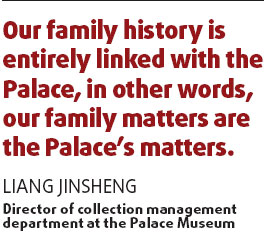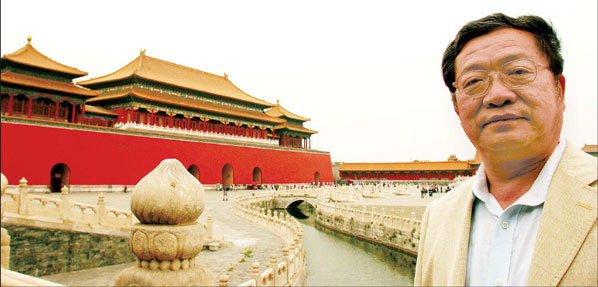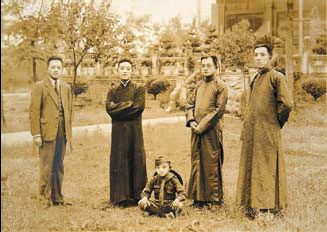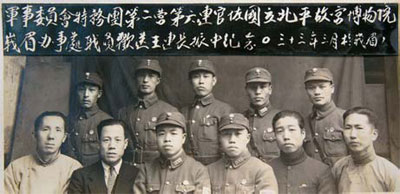Imperial treasure guards
|
Liang Jinsheng, a member of the fifth generation of the Liang family, works for the Palace Museum in the Forbidden City in Beijing. Jiang Dong |
Liang Jinsheng just celebrated his 60th birthday. But rather than look forward to his retirement, the Beijinger has grown anxious about leaving his work - because it could mark the end of an imperial legend of sorts.
The Liang family has been working for the Imperial Palace (the Palace Museum) for five generations, the only one among thousands of palace employees in the capital able to make that claim.
From imperial painters and antique inspectors, to escorts of national treasures during the chaos of war, the family's destiny has always been tied with the palace.
What makes the family's story more remarkable is how it was separated on both sides of the Taiwan Straits, after some of its members escorted some treasures to Taiwan in 1949.
|
A file photo shows Liang Jinsheng's grandfather Liang Tingwei (second from left) with other staff from the Palace Museum in Chongqing during the transportation of relics in the late 1930s. |
The family was reunited only four decades later.
"Our family history is entirely linked with the Palace, in other words, our family matters are the palace's matters," Liang says, grinning with pride.
Being an optimist, the director of the collection management department at the Palace Museum makes few references to his family's heartbreaking separation.
"I think it is great to be able to follow the older generations' footsteps," he explains. "My grandfather transferred national treasures out of Beijing, while my father was responsible for sending them back.
"And I have been charged with putting them in order."
Even now, Liang still rides a bicycle to work, not because he cannot afford to buy a car, but because he loves drinking, so a bike makes things a little more convenient for him.
In the morning, he cycles through Donghuamen, the east gate of the Palace, to reach his office, a traditional quadrangle, or siheyuan, surrounded by trees inside the Palace.
The Palace's red, thick wall completely blocks the office from the outside world - no towering mansions or annoying traffic. The buildings in the compound are shrouded in silence, with only the occasional cawing of crows.
Despite being an antique manager, there are no relics in Liang's 8-sq-m office, except for one fake porcelain piece left by a visitor.
"As someone working for a museum, it will be better not to have a habit of collecting or displaying personal collections in the office, which can complicate things," he says.
Liang's great-great-grandfather, Liang Derun, was in charge of the Palace studio in the Qing Dynasty (1644-1911), which can be traced back 150 years. He focused on various subjects, and was particularly good at figure painting.
More than 50 pieces of his artwork are in the Palace's collections, which Liang is very proud of.
Because of Liang Derun's reputation, Liang's great-grandfather Liang Shieng and grandfather Liang Tingwei, were successively asked to paint for the royal family. Liang Tingwei later became an antique inspector of the Palace after China's last emperor, Puyi, was driven out of the Forbidden City in 1924.
Following the invasion by Japan in 1931 and in order to protect the Palace's national treasures, all top quality art pieces were fitted into more than 14,000 chests, to be transported out of the capital.
In 1933, Liang Tingwei left his family in Beijing and escorted the treasures to Nanjing, capital of Jiangsu province.
"The shipment was not unloaded when the train arrived in Nanjing, as the government had not found a suitable place to store the treasures. So they had no choice but head for Shanghai instead," Liang recalls.
Four years later, the treasures were sent back from Shanghai to Nanjing, where a new warehouse was built to house them. Liang's family was reunited briefly that same year.
However, the situation deteriorated after the outbreak of the July 7 Incident, which marked the beginning of the War of Resistance Against Japanese Aggression (1937- 45).
The Palace's priceless pieces had to move again, this time headed for Sichuan province.

The transport routes were divided into three sections: A northern one by train, a middle option by ship and a southern route by bus. Liang's family followed the rail route.
It was a thrilling ride. The group faced various risks - bad weather, dangerous road conditions, bombing by Japanese forces and bandits.
"They didn't lose any treasure chests, as the journey was part of a convoy of Kuomintang troops. The troops had machine-guns on each carriage to guard against attacks," Liang recalls.
It took eight years to transfer all the treasures to Sichuan, where Liang's father, Liang Kuangzhong, had to give up his studies because of financial difficulties. He started working for the museum as a warehouse keeper at the age of 17.
Liang Kuangzhong named his five children based on the places where they were born, reflecting vividly the process of the treasures' movement.
For instance, Liang's eldest brother was born in Emei, Sichuan, so he was named "Esheng", while Liang was called "Jinsheng", because he was born in Nanjing (known as "Jinling" in the past) in 1948, one year after the treasures were returned to the city following the victory over the resistance war.
In early 1949, the Kuomintang government took 2,972 treasure chests to Taiwan after deciding that their situation on the mainland was beyond salvation.
"They selected the essence of the collection," Liang says.
"It is like moving house in a limited amount of time. What you want to take away are the most valuable things."
Liang's family was separated again with the move. His grandparents, two uncles and eldest brother went to the island as well.
None of them thought that the separation would last so long, or that it would be the last time some would see each other.
Liang's grandparents and mother all died before the family could be together again.
In the 1950s, the family moved back to Beijing when the treasures were sent back to the capital.
For the young Liang, there was no better playground than the Palace. He played hide-and-seek with friends and caught crickets. In summer, he would help weed the Palace to earn money for tuition fees. "The Palace is my home," he recalls, smiling.
In 1968, Liang responded to calls from the government and volunteered to work in the Inner Mongolia autonomous region.
But life did not treat him well there. Because of his overseas connections, Liang was not only rejected by the university, but was also refused to work at local factories.
After toiling as a farmer for more than 11 years, he returned to Beijing in 1979. Liang passed the entrance requirements of the Palace and became a construction worker. A few years later, he was transferred to the collection management department.
In 1986, the Palace received a Chinese-American guest surnamed Wu, who used to work for the Taipei Palace Museum (TPM). His appearance lightened Liang's hope of finding his family members.
Under Wu's help, his relatives were contacted in Taiwan. Liang's eldest brother eventually got to Beijing by the end of the 1980s.
"I spotted him immediately, among hundreds of passengers arriving at the airport. We have similar facial features," Liang recalls,
"But he seemed more like a guest to me, rather than a brother, because we didn't really share any life experiences," he adds.
Since 1996, Liang has visited Taiwan twice for business.
Liang says cross-Straits communication between the TPM and the Palace has increased over the past decades, through publications and work exchanges, even though there has been no exchange of exhibits.
"I hope the Palace exhibits on both sides of the Taiwan Straits will be unified one day," he says.
Currently, the registered number of Palace antiques stands at 1.5 million pieces in Beijing.
To protect the treasures, an underground warehouse was built in the Palace in 1998. More than 800,000 pieces, including books, are housed in the 30,000-sq-m area.
|
Liang Jinsheng's father Liang Kuangzhong (front row, second from right) with Kuomintang troops who guarded the Palace relics during their transfer. Photos courtesy of Liang Jinsheng |
"The number of top grade antiques has reached more than 8,000 pieces. Each of them is priceless," he says.
Working with the national treasures has made the man picky over antiques. He confesses that he hardly visits Panjiayuan, a famous antique market in the capital, as he believes there is no one item worth a second look.
"The Palace used to be the home of the royal family, therefore the ways of displaying the items depended on living habits and administrative needs," Liang explains.
"Now, the place has turned into a museum with a different management system. Too much needs to be done, which is impossible to be completed in the hands of one generation."
Liang's father, who devoted his life to the museum, died last year at the age of 84.
Liang's son, a tour guide, has no intention of carrying on the family work, saying that the job is too tranquil.
Currently, the only potential candidate to continue the tradition is Liang's nephew, who has shown interest in working for the Palace.
"It would be a terrible pity if the family legacy ended with my generation. I wish the young ones would follow in my footsteps, generation after generation," Liang says.
(China Daily 05/27/2008 page18)

















